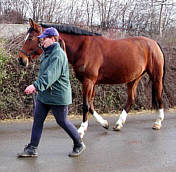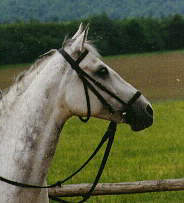
powered by FreeFind
| Main Page | Address |
| A-Z | Forum |
| German Main Page | |
|
Search
Web Search powered by FreeFind |
|
||||||||
 |
reiter.spass.com
Joy and Fun with Horses and Horseback Riding |
 |
Report for beginnersThe behavior and contact with the horse from the pack to the riding-place. Authored by Beate Schulze and translated by Martina Wald |
||
|
||||||
|
The behaviour and contact with the horse from the pack to the riding-place.When you fetch your horse from the pack or from the box, the following is to be valid: First talking, then touching. Approach to the horse, if it is possible, from the front, so that it can see you already (in the box you should talk to your horse already from the outside - it will turn to you almost always). Then touch it at the neck or head and take to the halter at the same time. Attach then the leading-rope on it at first. During the walk you go next to the
horse in height between head and shoulder. Therefore you are not in the
direction of the motion and, it its possibly wedging-out; you are not in the
area of the hind legs). You always led the horse on the left side. The leading-rope must not hang down so that the horse cannot step onto. (If you let your horse in the paddock again: Ensure yourself that it is standing with the head in direction to the entry and to you as well. After you let it go, bring yourself immediately out of the danger zone after leaving it of the leading-rope – many horses do a leap-frog or storm when they enter into the pack. Under no circumstances you must not stand in this way. If the horse is standing with its head in direction to the exit and to you, it has to turn round around to go to the paddock inside. You can use this time in order to leave the paddock and to close the gate.). Lead that always in step without fast movements, load voices etc. Your horse raise to stand remaining it you stand. After repeated practicing, your horse will understood this practice very fast. When you have to lead your horse from the paddock to the stable over a street, so at first the snaffle is to be put on. At the cleaning place it is to keep
sufficient space to the neighbour horse, in such a space, you can not be
wedged in between the horses and secondly that no fight between the horses
car arise. Tie your horse always normally to the tying-pole and raise it in
such a way, that from the beginning, it remains to stand and does not
“creeping”. Skew stand to other horses in particular provokes unrest and can
possibly support quarrels with kick-outs etc. The fixing of the rope has to happen with a special knot, thus, the horse can be left out at any time if there is panic. While putting on the saddle it is hung up by the front on the neck and to push backwards into the saddle situation, thus, the hairs of the horse are formed backwards in a sensitive way. (You may never hang up the saddle behind and then shifting the saddle in front. The skin will hurt and that can lead to saddle pressure.) To the bridling: Before taking off
the halter, the reins are to be put over the neck so that the horse can not
run away while bridling. For leading your horse to the riding-place you take the reins over the neck, catch the reins shortly behind the snaffle, take the reins and put the rest of their in slopes into the other hand ends, thus, their do not hand down. Like leading the horse with leading-rope you go to the left beside the horse. If several riders finish their horses for a riding-hour, the whole group goes to the place, so that the last horse does not get into panic if all others go away. (Take notice: the horse is a gregarious animal and wants to follow the group every time! That fact should be important for your behaviour to that!) It is normal, that you are in the
stable 30 minutes before the riding-hour starts. 2 minutes before the hour starts,
the whole group goes to the riding-place. Under no circumstances do tie up the
auxiliary reins. Then the rein comes over the horse’s head and you can sit up. If you have problems while sitting up, do not hesitate asking somebody for aid. The riding starts if the first command was happening. |
| Copyright © 2003 / 2007 reiter.spass.com, Forchheim, Germany | Disclaimer of reiter.spass.com | |
|
|
||